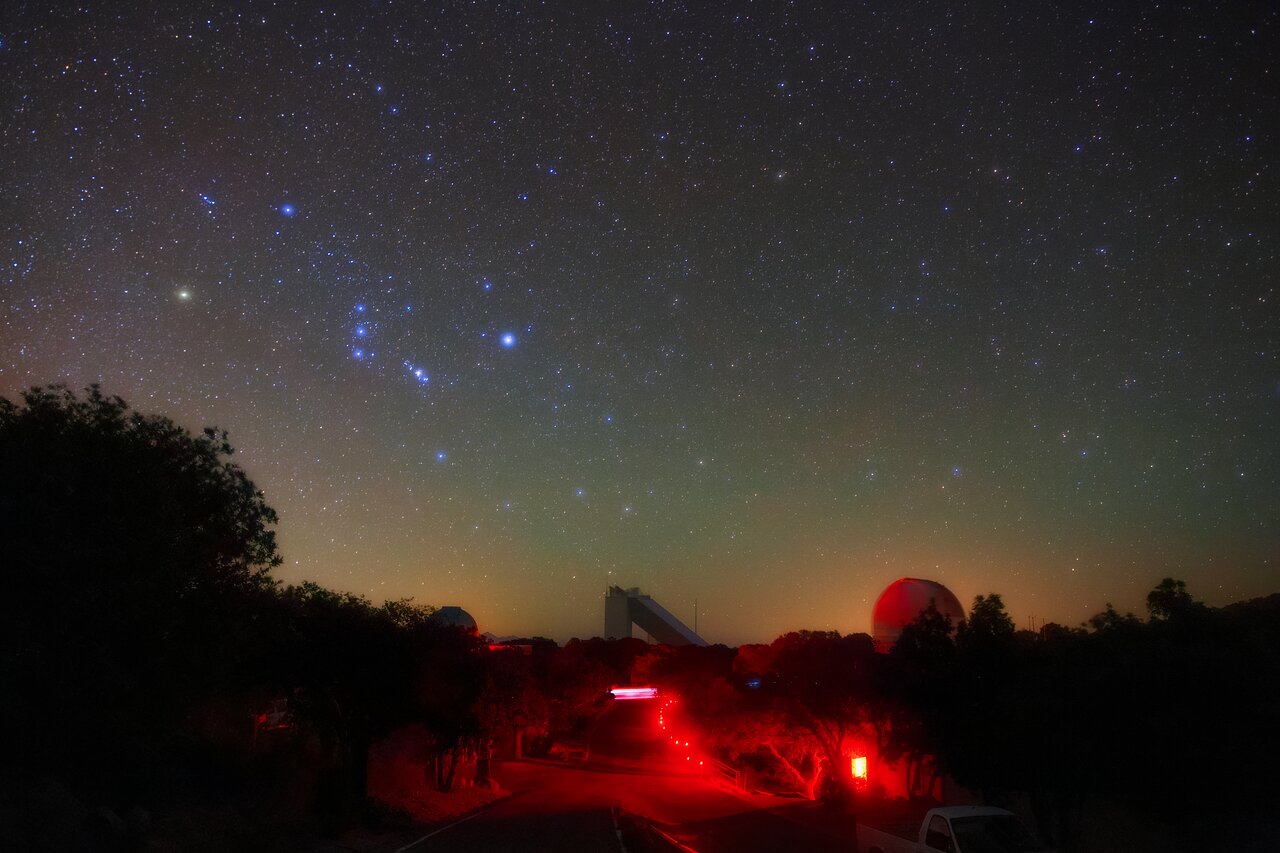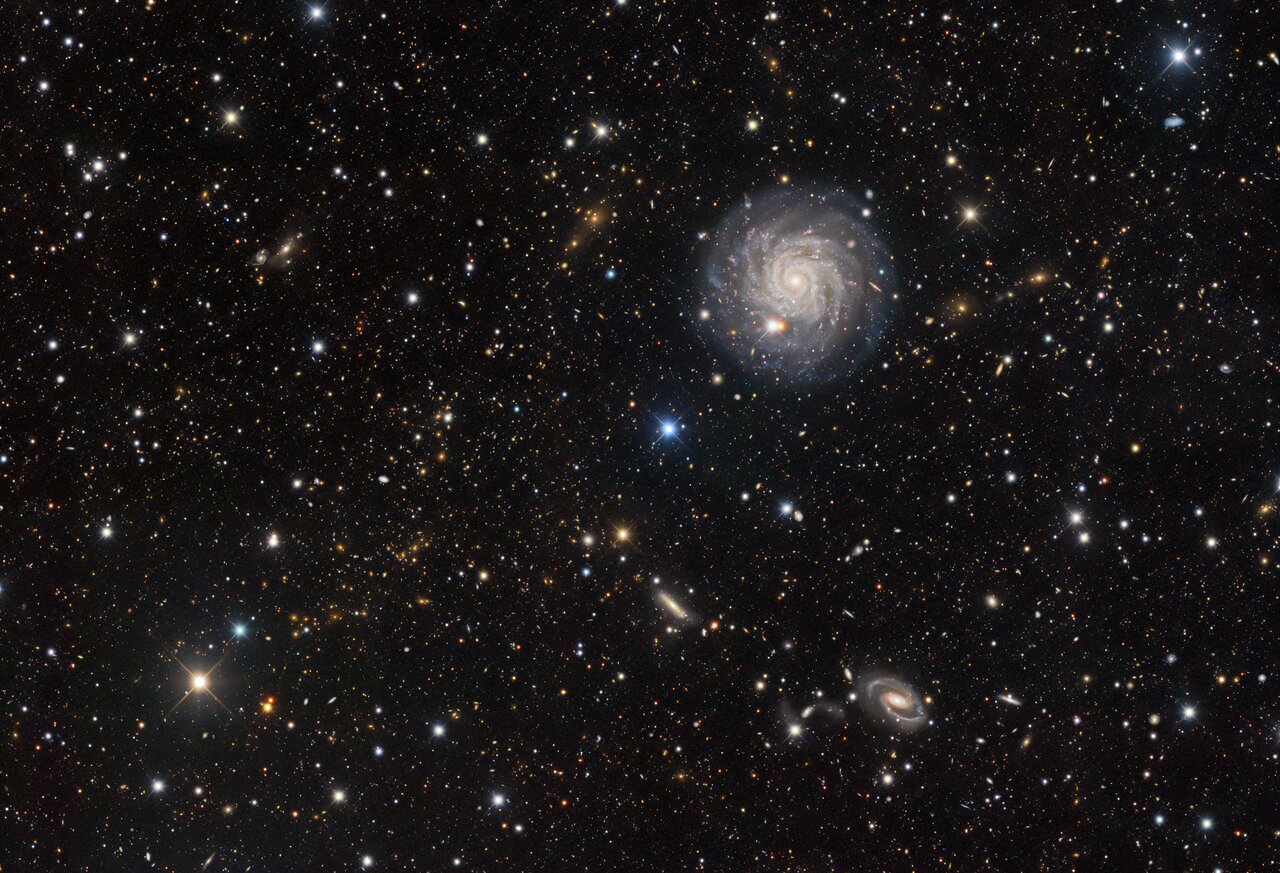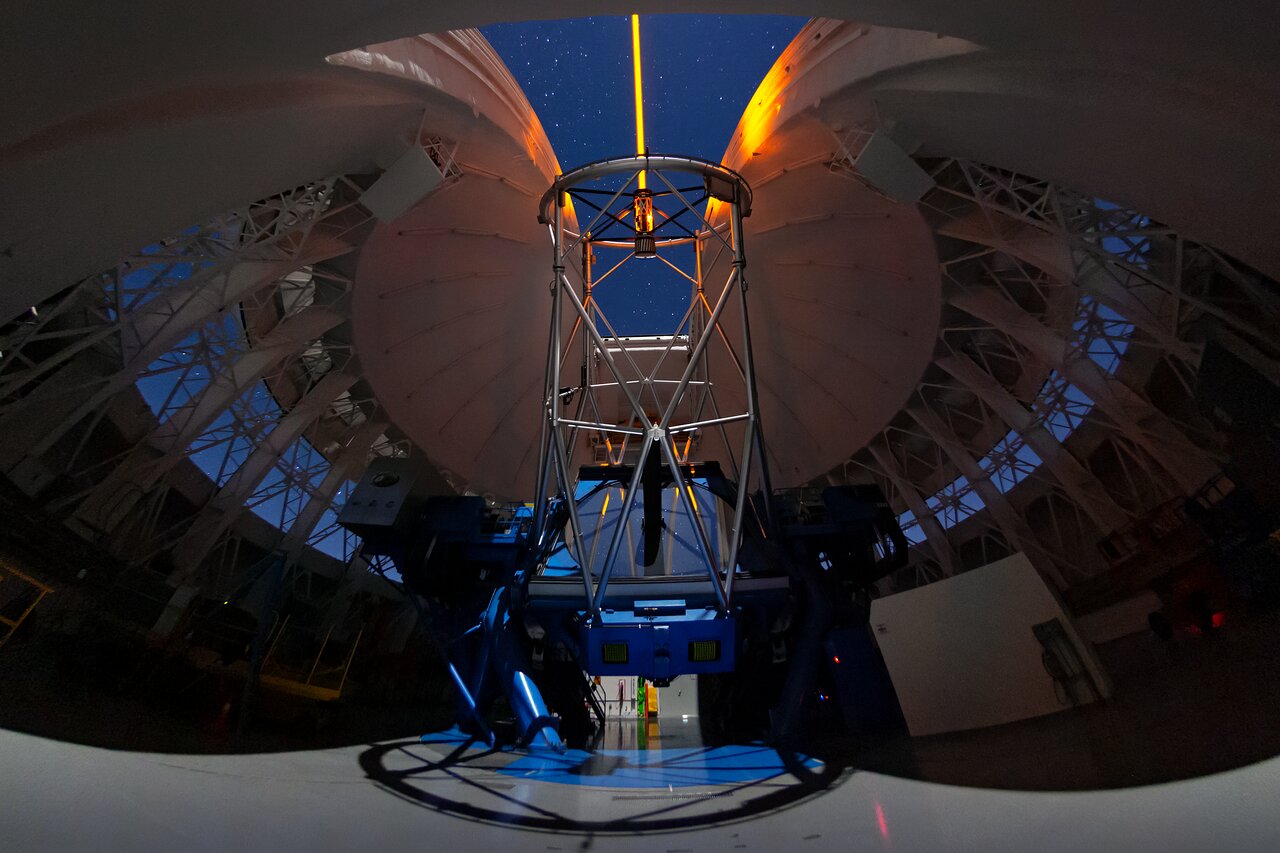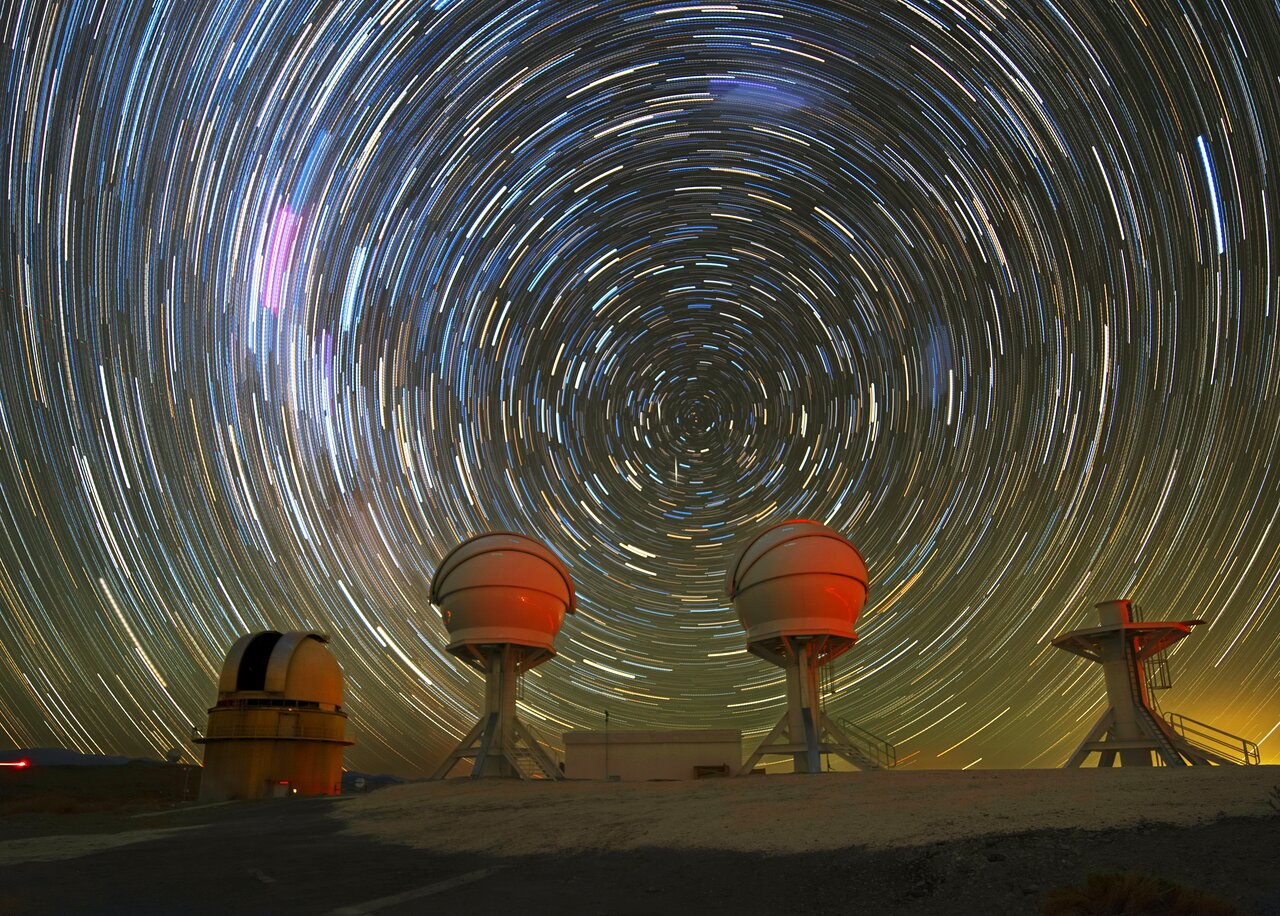Found Images: 2022 March
-
starsurfer
- Stellar Cartographer
- Posts: 5409
- Joined: Thu Mar 15, 2012 7:25 pm
-
starsurfer
- Stellar Cartographer
- Posts: 5409
- Joined: Thu Mar 15, 2012 7:25 pm
-
starsurfer
- Stellar Cartographer
- Posts: 5409
- Joined: Thu Mar 15, 2012 7:25 pm
-
starsurfer
- Stellar Cartographer
- Posts: 5409
- Joined: Thu Mar 15, 2012 7:25 pm
NOIRLab: Red Lights, Blue Lights (KPNO)
Red Lights, Blue Lights
NOIRLab Image of the Week | 2022 Mar 16
NOIRLab Image of the Week | 2022 Mar 16
The bright stars of the constellation Orion blaze in blue over Kitt Peak National Observatory (KPNO), a Program of NSF’s NOIRLab, in this image. They shine in stark contrast to the red lights lining the road approaching the observatory. The use of red lights might give this image a slightly otherworldly appearance, but they serve an important purpose: preserving the night vision of on-site staff and visitors. Red light preserves night vision better than other colors but is still bright enough to allow people to see what they are doing in a dark environment. It also interferes less with observing runs compared to blue or white light. The red lights look bright in this image, but that’s a result of the long exposure time used to capture the night sky. If you were at KPNO in person, the red lights would look far dimmer. In between the blue lights of the sky and the red lights of the ground, the McMath-Pierce Solar Telescope can be seen on the horizon.
Know the quiet place within your heart and touch the rainbow of possibility; be
alive to the gentle breeze of communication, and please stop being such a jerk. — Garrison Keillor
alive to the gentle breeze of communication, and please stop being such a jerk. — Garrison Keillor
ESO: Taming the Sky (VLT)
Taming the Sky
ESO Picture of the Week | 2022 Mar 21
ESO Picture of the Week | 2022 Mar 21
Powerful laser beams leave Unit Telescope 4 at ESO’s Very Large Telescope (VLT), located in the Atacama Desert in Chile. Their destination? An upper layer of the Earth’s atmosphere, about 90 kilometres from the ground, rich in sodium atoms.
The colour of the lasers is tuned to excite these atoms, making them shine brightly, like stars. Astronomers then use these artificial stars to calculate the blurring effect that Earth’s turbulent atmosphere creates on the light from astronomical objects. A deformable mirror uses this information to correct this blur in real time with a technique known as adaptive optics, which leads to much sharper observations.
This telescope, also known as Yepun, is the only one at the VLT equipped with a Laser Guide Star Facility. Each beam is 30 centimetres wide and packs 22 watts of power. For safety reasons, the system is equipped with cameras monitoring the part of the sky occupied by the lasers, so that when an airplane flying by is detected approaching this area, the lasers are promptly switched off.
Know the quiet place within your heart and touch the rainbow of possibility; be
alive to the gentle breeze of communication, and please stop being such a jerk. — Garrison Keillor
alive to the gentle breeze of communication, and please stop being such a jerk. — Garrison Keillor
ESA: Hubble Spies a Stunning Spiral (NGC 4571)
Hubble Spies a Stunning Spiral
ESA Hubble Picture of the Week | 2022 Mar 21
ESA Hubble Picture of the Week | 2022 Mar 21
This cosmic portrait — captured with the NASA/ESA Hubble Space Telescope’s Wide Field Camera 3 (WFC3) — shows a stunning view of the spiral galaxy NGC 4571, which lies approximately 60 million light-years from Earth in the constellation Coma Berenices. This constellation — whose name translates as Bernice’s Hair — was named after an Egyptian queen who lived more than 2200 years ago.
As majestic as spiral galaxies like NGC 4571 are, they are far from the largest structures known to astronomers. NGC 4571 is part of the Virgo cluster, which contains more than a thousand galaxies. This cluster is in turn part of the larger Virgo supercluster, which also encompasses the Local Group which contains our own galaxy, the Milky Way. Even larger than superclusters are galaxy filaments — the largest known structures in the Universe.
This image comes from a large programme of observations designed to produce a treasure trove of combined observations from two great observatories: Hubble and ALMA. ALMA, The Atacama Large Millimeter/submillimeter Array, is a vast telescope consisting of 66 high-precision antennas high in the Chilean Andes, which together observe at wavelengths between infrared and radio waves. This allows ALMA to detect the clouds of cool interstellar dust which give rise to new stars. Hubble’s razor-sharp observations at ultraviolet wavelengths, meanwhile, allows astronomers to pinpoint the location of hot, luminous, newly formed stars. Together, the ALMA and Hubble observations provide a vital repository of data to astronomers studying star formation, as well as laying the groundwork for future science with the NASA/ESA/CSA James Webb Space Telescope (JWST).
Know the quiet place within your heart and touch the rainbow of possibility; be
alive to the gentle breeze of communication, and please stop being such a jerk. — Garrison Keillor
alive to the gentle breeze of communication, and please stop being such a jerk. — Garrison Keillor
-
starsurfer
- Stellar Cartographer
- Posts: 5409
- Joined: Thu Mar 15, 2012 7:25 pm
-
starsurfer
- Stellar Cartographer
- Posts: 5409
- Joined: Thu Mar 15, 2012 7:25 pm
-
starsurfer
- Stellar Cartographer
- Posts: 5409
- Joined: Thu Mar 15, 2012 7:25 pm
-
starsurfer
- Stellar Cartographer
- Posts: 5409
- Joined: Thu Mar 15, 2012 7:25 pm
-
starsurfer
- Stellar Cartographer
- Posts: 5409
- Joined: Thu Mar 15, 2012 7:25 pm
Re: Found Images: 2022 March
A moonbow and an aurora
Copyright: Ylva Sarri
This is a screenshot from the Swedish TV-show "Sverige idag" (Sweden today). I don't know where else to find this picture.
I believe it is very unusual to see a moonbow and an aurora at the same time. The photographer reported that it had been raining heavily before it cleared up, and moonlight created the moonbow. An aurora could be seen at the same time.
Ann
Copyright: Ylva Sarri
This is a screenshot from the Swedish TV-show "Sverige idag" (Sweden today). I don't know where else to find this picture.
I believe it is very unusual to see a moonbow and an aurora at the same time. The photographer reported that it had been raining heavily before it cleared up, and moonlight created the moonbow. An aurora could be seen at the same time.
Ann
Color Commentator
Re: Found Images: 2022 March
M82 Galaxy
12 "Truss RC telescope reduced to 1790
Moravian off-axis guider and Moravian G0300 guide camera
Celestron 80/600 guide tube with Asi Zwo 224 chamber
Moravian G2 8300 camera with internal wheel
Ioptron Cem120 mount
Moonlite focuser and 3.5 "electronic rotator
Electronic temperature control and anti-condensation
bands Cls ccd, R, G, B, Ha 6nm filters, all Astronomik
Shooting data: 21x600 HA 49x300 L 21x240 R 21x240 G 21x240 B
Processing: Pixinsight, Photoshop, star spikes, astronomy tools
Luca Dinoi
12 "Truss RC telescope reduced to 1790
Moravian off-axis guider and Moravian G0300 guide camera
Celestron 80/600 guide tube with Asi Zwo 224 chamber
Moravian G2 8300 camera with internal wheel
Ioptron Cem120 mount
Moonlite focuser and 3.5 "electronic rotator
Electronic temperature control and anti-condensation
bands Cls ccd, R, G, B, Ha 6nm filters, all Astronomik
Shooting data: 21x600 HA 49x300 L 21x240 R 21x240 G 21x240 B
Processing: Pixinsight, Photoshop, star spikes, astronomy tools
Luca Dinoi
-
starsurfer
- Stellar Cartographer
- Posts: 5409
- Joined: Thu Mar 15, 2012 7:25 pm
Re: Found Images: 2022 March
NGC 1703
https://noirlab.edu/public/images/iotw2210a/
Copyright: Dark Energy Survey/DOE/FNAL/DECam/CTIO/NOIRLab/NSF/AURA
Processing: T.A. Rector (University of Alaska Anchorage/NSF’s NOIRLab), J. Miller (Gemini Observatory/NSF’s NOIRLab), M. Zamani & D. de Martin (NSF’s NOIRLab)
https://noirlab.edu/public/images/iotw2210a/
Copyright: Dark Energy Survey/DOE/FNAL/DECam/CTIO/NOIRLab/NSF/AURA
Processing: T.A. Rector (University of Alaska Anchorage/NSF’s NOIRLab), J. Miller (Gemini Observatory/NSF’s NOIRLab), M. Zamani & D. de Martin (NSF’s NOIRLab)
-
starsurfer
- Stellar Cartographer
- Posts: 5409
- Joined: Thu Mar 15, 2012 7:25 pm
Re: Found Images: 2022 March
NGC 1291
http://www.atacama-photographic-observa ... php?id=213
Copyright: Thierry Demange, Richard Galli and Thomas Petit
http://www.atacama-photographic-observa ... php?id=213
Copyright: Thierry Demange, Richard Galli and Thomas Petit
NOIRLab: A Guiding Star for Gemini South
A Guiding Star for Gemini South
NOIRLab Image of the Week | 2022 Mar 23
NOIRLab Image of the Week | 2022 Mar 23
This Image of the Week captures the use of the laser guide star (LGS) on Gemini South, the southern twin of the international Gemini Observatory, a Program of NSF’s NOIRLab, during a night of observations on Cerro Pachón in the Chilean Andes. The LGS creates a constellation of five artificial stars, by causing sodium atoms 90 kilometers up in the atmosphere to glow. By tracking the atmosphere’s effect on these “stars”, the adaptive optics system within Gemini South can correct for distortions caused by turbulence in the atmosphere. These adjustments improve observations so much that a squiggle of light can become a distinct star, galaxy or other astronomical object. While it may seem that this laser must be shockingly powerful, it actually uses only 10–15 watts of energy, about the same as a bedside lamp. A similar LGS system is in use at Gemini North, which you can see in action in this earlier Image of the Week.
Know the quiet place within your heart and touch the rainbow of possibility; be
alive to the gentle breeze of communication, and please stop being such a jerk. — Garrison Keillor
alive to the gentle breeze of communication, and please stop being such a jerk. — Garrison Keillor
ESO: Searching for Gems (BlackGEM)
Searching for Gems
ESO Picture of the Week | 2022 Mar 28
ESO Picture of the Week | 2022 Mar 28
This striking star trail image was captured above ESO’s La Silla Observatory, in Chile’s Atacama desert. Star trails are caused by Earth’s rotation; in this long exposure image, stars appear to circle around the south celestial pole. Almost unrecognisable are the Carina Nebula (bright magenta smudge, centre-left) and the Large and Small Magellanic Clouds (blue smudges in the centre-top and centre-right, respectively).
Gazing up into the starry vortex are two of the three BlackGEM telescopes, built and operated by Radboud University, the Netherlands Research School for Astronomy (NOVA), and KU Leuven.The third telescope on the right was still under construction at the time this photograph was taken, having only a platform and no dome. BlackGEM eventually aims to expand to 15 telescopes, capable of performing extensive surveys of the night sky.
BlackGEM will join detectors such as LIGO and Virgo in the search for the most dramatic events in space, such as merging black holes and neutron stars. Following the detection of gravitational waves from these collisions by LIGO and Virgo, BlackGEM will scan large areas of the sky looking for the visible light emitted in these events. Other facilities like ESO’s Very Large Telescope will then follow up on BlackGEM’s measurements, enabling astronomers to better understand some of our universe’s most elusive phenomena.
Know the quiet place within your heart and touch the rainbow of possibility; be
alive to the gentle breeze of communication, and please stop being such a jerk. — Garrison Keillor
alive to the gentle breeze of communication, and please stop being such a jerk. — Garrison Keillor
ESA: More Than Meets the Eye (NGC 7172)
More Than Meets the Eye
ESA Hubble Picture of the Week | 2022 Mar 28
ESA Hubble Picture of the Week | 2022 Mar 28
Tendrils of dark dust can be seen threading across the heart of the spiral galaxy NGC 7172 in this image from the NASA/ESA Hubble Space Telescope. The galaxy lies approximately 110 million light-years from Earth in the constellation Piscis Austrinus. The lane of dust threading its way across NGC 7172 — which is viewed side-on in this image — is obscuring the luminous heart of the galaxy, making NGC 7172 appear to be nothing more than a normal edge-on spiral galaxy.
When astronomers inspected NGC 7172 across the electromagnetic spectrum they quickly discovered that there was more to it than meets the eye: NGC 7172 is a Seyfert galaxy — a type of galaxy with an intensely luminous active galactic nucleus powered by matter accreting onto a supermassive black hole.
This image combines data from two sets of Hubble observations, both of which were proposed to study nearby active galactic nuclei. The image also combines data from two instruments — Hubble’s Advanced Camera for Surveys (ACS) and Wide Field Camera 3 (WFC3).
Know the quiet place within your heart and touch the rainbow of possibility; be
alive to the gentle breeze of communication, and please stop being such a jerk. — Garrison Keillor
alive to the gentle breeze of communication, and please stop being such a jerk. — Garrison Keillor
- AVAO
- Commander
- Posts: 787
- Joined: Tue May 28, 2019 12:24 pm
- AKA: multiwavelength traveller
- Location: Zurich, Switzerland
Re: Found Images: 2022 March
Zooming into the Sun with Solar Orbiter
"Solar Orbiter’s latest images shows the full Sun in unprecedented detail. They were taken on 7 March, when the spacecraft was crossing directly between the Earth and Sun. One of the images, taken by the Extreme Ultraviolet Imager (EUI) is the highest resolution image of the Sun’s full disc and outer atmosphere, the corona, ever taken."
https://www.esa.int/Science_Exploration ... ar_Orbiter
Interesting cutout from the whole image:

https://live.staticflickr.com/65535/519 ... abad_k.jpg
Image Credit: ESA & NASA/Solar Orbiter/EUI team; Data processing: E. Kraaikamp (ROB)
"Solar Orbiter’s latest images shows the full Sun in unprecedented detail. They were taken on 7 March, when the spacecraft was crossing directly between the Earth and Sun. One of the images, taken by the Extreme Ultraviolet Imager (EUI) is the highest resolution image of the Sun’s full disc and outer atmosphere, the corona, ever taken."
https://www.esa.int/Science_Exploration ... ar_Orbiter
Interesting cutout from the whole image:

https://live.staticflickr.com/65535/519 ... abad_k.jpg
Image Credit: ESA & NASA/Solar Orbiter/EUI team; Data processing: E. Kraaikamp (ROB)
-
starsurfer
- Stellar Cartographer
- Posts: 5409
- Joined: Thu Mar 15, 2012 7:25 pm
-
starsurfer
- Stellar Cartographer
- Posts: 5409
- Joined: Thu Mar 15, 2012 7:25 pm
-
starsurfer
- Stellar Cartographer
- Posts: 5409
- Joined: Thu Mar 15, 2012 7:25 pm
-
starsurfer
- Stellar Cartographer
- Posts: 5409
- Joined: Thu Mar 15, 2012 7:25 pm
NOIRLab: Smoke and Mirrors (Gemini North)
Smoke and Mirrors
NOIRLab Image of the Week | 2022 Mar 30
NOIRLab Image of the Week | 2022 Mar 30
Gemini North, of the international Gemini Observatory (a Program of NSF’s NOIRLab), stands peacefully in the foreground, under a crystal clear sky. If you narrow your eyes, however, it looks a little as though the telescope in the background of this image is on fire, sending plumes of smoke up into the starry sky. Fortunately, Gemini North’s near neighbor is not ablaze! The dramatic upward sweep of milky and sooty patches is in fact the Milky Way galaxy.
The dark tendrils that permeate the Milky Way are due to enormous clouds of cosmic dust. These clouds of tiny particles absorb and scatter light, making huge patches of the Milky Way appear dark to human eyes from our vantage point here on Earth. Telescopes such as Gemini North, however, see the night sky differently. They are designed to collect far more light that the human eye can, thanks to their large primary mirrors. They can also detect ranges of light that humans cannot, meaning that they can probe areas of cosmic dust, giving us information on things that would otherwise remain obscured.
Know the quiet place within your heart and touch the rainbow of possibility; be
alive to the gentle breeze of communication, and please stop being such a jerk. — Garrison Keillor
alive to the gentle breeze of communication, and please stop being such a jerk. — Garrison Keillor








